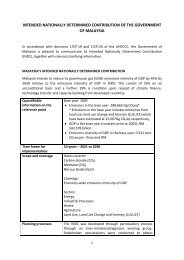RP-01638
RP-01638
RP-01638
You also want an ePaper? Increase the reach of your titles
YUMPU automatically turns print PDFs into web optimized ePapers that Google loves.
At a standard frequency of about 40 strokes<br />
per minute, the same 20-L can was filled to<br />
capacity while counting the actual number<br />
(n,) of strokes. The volumetric efficiency was<br />
then computed from the formula:<br />
Volumetric efficiency (%) _ (nu,/n,) x 100<br />
The water head (distance between the<br />
water level in the well and the pump spout)<br />
was measured by using a calibrated string<br />
weighted at one end with a float.<br />
Since no counter was installed to measure<br />
pump usage, the determination of total<br />
volume of water pumped was estimated.<br />
Monitors at the village recorded the number<br />
of 20-L cans (provided at the pump site for<br />
this purpose) that the village people pumped<br />
per day. This was used as the basis to estimate<br />
the amount of water pumped per month.<br />
The thickness of the upper and lower<br />
piston rings at three points was measured<br />
monthly. The percentage rate of wear was<br />
then determined from the past and present<br />
measurements.<br />
Highlights of Findings<br />
The project was able to install 30 Waterloo<br />
pumps in several areas: Jala Jala Islands in<br />
Laguna (10), Cavite (9), Pangasinan (7), and<br />
Nueva Ecija (4). Of these 30 pumps, only 4<br />
(13%) were considered functional/operational<br />
and appropriate for monitoring purposes.<br />
The other 26 pumps were eventually abandoned<br />
as they were beset with one or more<br />
of the following seven problems: (1) high<br />
leakage rate; (2) users found the pump to be<br />
very difficult, strenuous, and inconvenient to<br />
use because it took quite a long time to prime<br />
and draw water. (This situation is described<br />
with humour by one user with the following<br />
statement: "Our sweat comes out first before<br />
we pump out water."); (3) defective foot<br />
valve; (4) caving in of the well; (5) people<br />
eventually abandoning the use of the pumps<br />
because they started to draw up brackish or<br />
muddy water; (6) piston stuck and could not<br />
be extracted; and (7) foot valve slipped out of<br />
the casing and dropped down the well.<br />
Given the alternative of being able to use<br />
other existing pumps (Jet-matic and pitcher<br />
pumps), the village users eventually switched<br />
to these other pumps. The original Waterloodesigned<br />
handpump that was fabricated<br />
according to specifications did not function<br />
as efficiently as expected when tested<br />
initially. The following specific observations<br />
were made.<br />
The foot valve did not hold water satisfactorily<br />
because: (1) the original gasket or the<br />
seal (polyethylene ring) was not effective;<br />
(2) sand particles became trapped between<br />
the plastic flapper valve and the valve seat<br />
and caused poor seating of the valve; and<br />
(3) there was excessive clearance between the<br />
valve guide and the flapper valve. The piston's<br />
performance was similar to that of the foot<br />
valve.<br />
Filter<br />
The PVC filter did not function adequately.<br />
This may have been because the screen slots<br />
were too big and allowed fine sand and silt to<br />
pass. Another reason was that some wells<br />
were not adequately developed.<br />
To try to overcome these problems,<br />
changes were made in the design of the foot<br />
valve. These changes included incorporating a<br />
brass spring, using a rubber gasket, and<br />
chamfering the valve seat to prevent sand<br />
particles from wedging between the flapper<br />
valve and the valve seat. These modifications<br />
improved the performance of the pumps<br />
slightly. However, it is not possible to state<br />
conclusively whether the improved performance<br />
was due solely to the modifications or<br />
was due to the fact that the wells had louver<br />
pumping heads: the four operational pumps<br />
had a water head of less than 10 feet (3 m).<br />
Even when the Malaysian foot-valve design<br />
was tried, technical problems with the foot<br />
valves continued to be a major constraint.<br />
One interesting finding that has always<br />
puzzled the team is the seepage rate encountered<br />
in all the wells. Although a stronger<br />
spring was installed for the flapper valve, a<br />
high seepage rate persisted. This meant that<br />
50-70 strokes of the pump handle were<br />
required to raise the water column so that<br />
water could be obtained; however, after a<br />
short period without pumping, the level of<br />
the water in the column fell back to the level<br />
of the ground water. Thus, priming had to be<br />
repeated. For areas with a high water table,<br />
like Aliaga, Nueva Ecija, and Pangasinan,<br />
the tedious process of raising the water<br />
column was not much of a problem. For<br />
deep wells, however, this is a very serious<br />
problem.<br />
37



